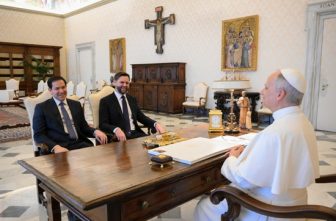It is the Fourth Sunday of Lent. Easter is only three weeks away, and Baptism moves to the forefront on Easter. Catechumens are baptized at the Easter Vigil. The faithful renew their baptismal promises and are sprinkled with holy water at the Easter Masses. This weekend the Scripture readings offer hints of Baptism that point ahead to Easter and the celebration of the greatest feast of the Christian faith.
There are four symbols of the Sacrament of Baptism. Three appear explicitly in this week’s Scripture readings: oil, light, and water; and one is implied, the baptismal garment.
 The conclusion to the first reading recounts how “Samuel, with the horn of oil in his hand, anointed [David] in the midst of his brothers, and from that day on, the spirit of the Lord rushed upon David” (1 Sm 16:13). The anointing of David with oil by the prophet Samuel prefigures the anointing of the catechumen with sacred chrism by the priest during the celebration of Baptism at the Easter Vigil, or the anointing with oil when anyone is baptized at any other time by a priest or deacon.
The conclusion to the first reading recounts how “Samuel, with the horn of oil in his hand, anointed [David] in the midst of his brothers, and from that day on, the spirit of the Lord rushed upon David” (1 Sm 16:13). The anointing of David with oil by the prophet Samuel prefigures the anointing of the catechumen with sacred chrism by the priest during the celebration of Baptism at the Easter Vigil, or the anointing with oil when anyone is baptized at any other time by a priest or deacon.
Both the second reading and the gospel mention light. St. Paul wrote, “Live as children of light” (Eph 5:8), and “Christ will give you light” (Eph 5:14). In the gospel Jesus says, “I am the light of the world” (Jn 9:5). The Easter Vigil begins with the Lucernarium, the Service of Light. Either at dusk outside or in the darkness inside, a fire is lit which ablaze gives off much light. Then the Easter Candle is lit, which radiates bright light. Next the deacon presents the lighted Easter Candle to the assembly and sings, “The Light of Christ,” because Jesus is the light of the world (see also Jn 8:12 and 12:46). Fire is then distributed to each person in the assembly, all who are holding candles, and gradually the church is filled with light. Finally, when the catechumen is baptized, a baptismal candle is lit from the Easter Candle and presented to the sponsor. Henceforth, the light of Jesus will lead the newly baptized to the truth and guide the person along right paths (see Ps 23:3).
The gospel builds upon the previous Scripture texts and includes three baptismal symbols. First, Jesus stated that he is light (Jn 9:5). Second, he bent down, made a mud paste with his saliva and the clay, and then smeared it on the man’s eyes (Jn 9:6). The Church has traditionally considered the smearing to be an anointing, and the mud paste to be equivalent to oil. Third, Jesus instructed the man, “Go wash in the Pool of Siloam” (Jn 9:7), and the man washed himself with water, the primary symbol of baptism. This points ahead to the Easter Vigil. The baptismal liturgy begins at the baptistry with the blessing of the water, and then those to be baptized are immersed in the water or have water poured over their heads.
The connections are many. David was anointed. The blind man was anointed. The catechumen will be anointed. Every person who has been baptized has been anointed. The light enables a person to see Jesus, and thus enlightened, to believe in him and do good. Those who are washed in the waters of baptism are among God’s chosen ones, “The Elect,” those who have their names inscribed in the Book of Life. Samuel chose David. Jesus chose the blind man. God chooses the newly baptized, as well as all those who have been baptized previously. The baptized have clothed themselves with Christ. Baptism is the beginning of the journey to eternal life.




